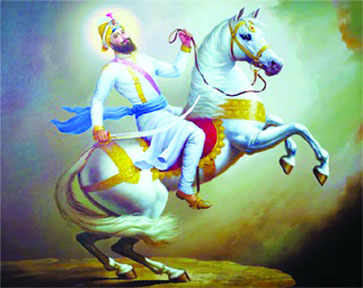
Guru Gobind Singh Ji, the tenth Sikh Guru, was born as Gobind Rai on 22 December 1666 in Patna, Bihar. His early life is a blend of extraordinary spiritual growth, intellectual development, and moments of deep tragedy that profoundly shaped his later contributions as a spiritual leader and warrior. This section explores his family background, formative years, education, and the events that set the stage for his lifelong mission to protect dharma and human rights.
Birth and Family Background
Gobind Rai was born to Guru Tegh Bahadur, the ninth Sikh Guru, and Mata Gujri Ji, a devout and wise woman who played an essential role in shaping his character. His birthplace, Patna Sahib, is now revered as one of the five Takhts (seats of authority) in Sikhism. The political and social climate during his birth was fraught with tension, as Mughal Emperor Aurangzeb was actively enforcing Islamic conversion policies, leading to oppression of Hindus and Sikhs alike.
Guru Tegh Bahadur was a spiritual leader and warrior who traveled extensively to spread the teachings of Sikhism and protect religious freedom. His wife, Mata Gujri, was a pillar of support, ensuring Gobind Rai grew up in an environment imbued with spirituality, discipline, and resilience. Gobind Rai was their only child, making him the center of their attention and guidance.
The Significance of Patna in His Early Years
While Guru Tegh Bahadur was away on his missionary journeys, Mata Gujri and Gobind Rai stayed in Patna. The town became a hub for the Sikh community during their stay. Gobind Rai’s early interactions with the local people of diverse faiths and backgrounds allowed him to develop a deep respect for cultural and religious diversity.
Even as a child, Gobind Rai exhibited signs of spiritual wisdom and bravery. It is said that his aura was so radiant that visitors often remarked on his extraordinary presence. Despite being born during a period of religious persecution, his childhood was marked by an innate curiosity about the world and an unwavering connection to the divine.
Guru Tegh Bahadur’s Influence
on Gobind Rai
One of the most significant influences in Gobind Rai’s life was his father, Guru Tegh Bahadur. Known as the “Protector of Humanity” (Hind Di Chadar), Guru Tegh Bahadur embodied the principles of selflessness and courage.
– Missionary Work: Guru Tegh Bahadur’s travels to Punjab, Assam, and Bengal brought him into contact with various communities, teaching Gobind Rai the importance of inclusivity.
– Sacrifices: The Guru’s willingness to stand against injustice, even at great personal cost, left a lasting impression on his son.
Guru Tegh Bahadur’s teachings laid the groundwork for Gobind Rai’s future role as a defender of human rights and a leader who would unify his community under the banner of equality and justice.
Formative Years and Education
Gobind Rai was not only raised as a spiritual seeker but also as a warrior and intellectual. His upbringing emphasized a holistic approach to leadership, balancing spiritual enlightenment with physical strength.
– Training in Martial Arts: Gobind Rai was trained in horse riding, archery, swordsmanship, and other forms of combat. This training prepared him to lead his people during tumultuous times.
– Study of Scriptures: He studied Sikh scriptures and other religious texts, including Hindu epics like the Mahabharata and Ramayana, gaining insights into dharma (righteousness) and leadership.
– Language Proficiency: Gobind Rai was proficient in multiple languages, including Punjabi, Sanskrit, Persian, and Braj, enabling him to connect with diverse communities and articulate his vision effectively.
His education was not limited to religious studies; it also included lessons in statecraft and diplomacy, which proved invaluable in his later dealings with hill chieftains and Mughal authorities.
Early Signs of Leadership
Even as a child, Gobind Rai demonstrated remarkable leadership qualities. He was known for his courage, intelligence, and ability to inspire others. Anecdotes from his childhood highlight his innate sense of justice and fairness.
– Incident of the Broken Toy Bow: A popular story recounts how young Gobind Rai refused to cry when his toy bow broke, stating that a true warrior does not mourn over minor losses. This incident symbolized his resilience and readiness to face challenges.
– Interactions with Saints and Scholars: Gobind Rai often engaged in discussions with visiting saints, absorbing their wisdom and demonstrating his deep understanding of spiritual concepts.
Martyrdom of Guru Tegh Bahadur
A defining moment in Gobind Rai’s early life was the martyrdom of his father. In 1675, Guru Tegh Bahadur was executed by Aurangzeb for refusing to convert to Islam and defending the religious freedom of Kashmiri Pandits.
– The Turning Point: At the age of nine, Gobind Rai witnessed the brutal consequences of tyranny. This event solidified his resolve to fight oppression and protect the rights of the marginalized.
– Acceptance of Guruship: Following his father’s death, Gobind Rai was formally installed as the tenth Guru of the Sikhs. Despite his young age, he took on the immense responsibility of leading his community through a period of crisis.
The sacrifice of Guru Tegh Bahadur became a rallying cry for Sikhs, and Gobind Rai’s leadership ensured that his father’s legacy of resistance and justice would endure.
Anandpur Sahib: A Hub of
Spiritual and Martial Training
After becoming the Guru, Gobind Rai established Anandpur Sahib, which became the epicenter of Sikhism under his guidance. It was here that he began to organize the Sikh community into a cohesive force, blending spirituality with martial discipline.
– Community Building: Anandpur Sahib attracted Sikhs from all over India, creating a sense of unity and purpose.
– Preparation for Future Battles: Gobind Rai encouraged the Sikhs to train in martial arts and self-defense, anticipating the need to resist future aggression.
Legacy of His Early Life
Gobind Rai’s early life was marked by a unique combination of spiritual wisdom, intellectual growth, and exposure to the harsh realities of life under an oppressive regime. These formative years laid the foundation for his later contributions as Guru Gobind Singh, the warrior-saint who would transform Sikhism and inspire generations to come.
– Spiritual Resilience: His connection to the divine and commitment to justice were evident from a young age.
– Leadership Qualities: His ability to inspire and lead others became apparent during his childhood.





931823 703216Deference to op , some superb selective info . 726784